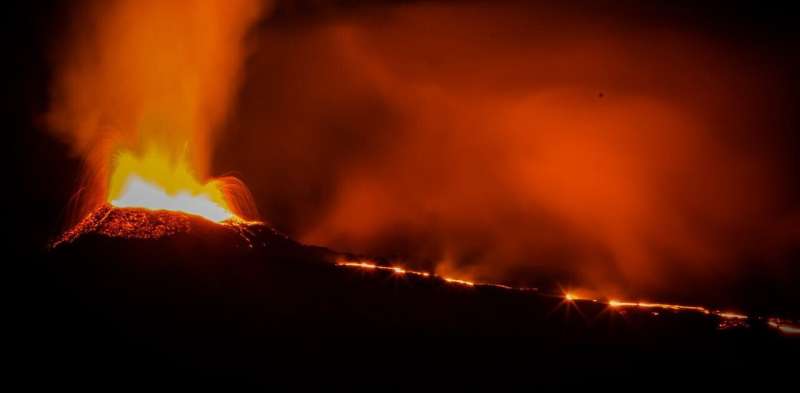Where does the Earth's heat come from?

Earth generates heat. The deeper you go, the higher the temperature. At 25km down, temperatures rise as high as 750°C; at the core, it is said to be 4,000°C. Humans have been making use of hot springs as far back as antiquity, and today we use geothermal technology to heat our apartments. Volcanic eruptions, geysers and earthquakes are all signs of the Earth's internal powerhouse.
The average heat flow from the earth's surface is 87mW/m2 – that is, 1/10,000th of the energy received from the sun, meaning the earth emits a total of 47 terawatts, the equivalent of several thousand nuclear power plants. The source of the earth's heat has long remained a mystery, but we now know that most of it is the result of radioactivity.
The birth of atoms
To understand where all this heat is coming from, we have to go back to the birth of the atomic elements.
The Big Bang produced matter in the form of protons, neutrons, electrons, and neutrinos. It took around 370,000 years for the first atoms to form—protons attracted electrons, producing hydrogen. Other, heavier nuclei, like deuterium and helium, formed at the same time, in a process called Big Bang nucleosynthesis.
The creation of heavy elements was far more arduous. First, stars were born and heavy nuclei formed via accretion in their fiery crucible. This process, called stellar nucleosynthesis, took billions of years. Then, when the stars died, these elements spread out across space to be captured in the form of planets.
The earth's composition is therefore highly complex. Luckily for us, and our existence, it includes all the natural elements, from the simplest atom, hydrogen, to heavy atoms such as uranium, and everything in between, carbon, iron—the entire periodic table. Inside the bowels of the earth is an entire panoply of elements, arranged within various onion-like layers.
We know little about the inside of our planet. The deepest mines reach down 10km at the most, while the earth has a radius of 6,500km. Scientific knowledge of deeper levels has been obtained through seismic measurements. Using this data, geologist divided the earth's structure into various strata, with the core at the center, solid on the inside and liquid on the outside, followed by the lower and upper mantles and, finally, the crust. The earth is made up of heavy, unstable elements and is therefore radioactive, meaning there is another way to find out about its depths and understand the source of its heat.

What is radioactivity?
Radioactivity is a common and inescapable natural phenomenon. Everything on earth is radioactive—that is to say, everything spontaneously produces elementary particles (humans emit a few thousand per second). In Marie Curie's day, no one was afraid of radioactivity.
On the contrary, it was said to have beneficial effects: beauty creams were certified radioactive and contemporary literature extolled the radioactive properties of mineral water. Maurice Leblanc wrote of a thermal spring saving his protagonist Arsène Lupin during one of his adventures: "The water contained such energy and power as to make it a veritable fountain of youth, properties arising from its incredible radioactivity." (Maurice Leblanc, "La demoiselle aux yeux verts", 1927)
There are various kinds of radioactivity, each involving the spontaneous release of particles and emitting energy that can be detected in the form of heat deposits. Here, we will be talking about "beta" decay, where an electron and a neutrino are emitted. The electron is absorbed as soon as it is produced, but the neutrino has the surprising ability to penetrate a wide range of materials. The whole of the Earth is transparent to neutrinos, so detecting neutrinos generated by radioactive decay within the Earth should give us an idea of what is happening at its deepest levels.
These kinds of particles are called geoneutrinos, and they provide an original way to investigate the depths of the Earth. Although detecting them is no easy matter, since neutrinos interact little with matter, some detectors are substantial enough to perform this kind of research.
Geoneutrinos mainly arise from heavy elements with very long half-lives, whose properties are now thoroughly understood through lab studies: chiefly uranium, thorium and potassium. The decay of one uranium-238 nucleus, for example, releases an average of 6 neutrinos, and 52 megaelectronvolts of energy carried by the released particles that then lodge in matter and deposit heat. Each neutrino carries around two megaelectronvolts of energy. According to standardized measures, one megaelectronvolt is equivalent to 1.6 10-13 joules, so it would take around 1025 decays per second to reach the earth's total heat. The question is, can these neutrinos be detected?
Detecting geoneutrinos
In practice, we have to take aggregate measurements at the detection site of flows coming from all directions. It is difficult to ascertain the exact source of the flows, since we cannot measure their direction. We have to use models to create computer simulations. Knowing the energy spectrum of each decay mode and modeling the density and position of the various geological strata affecting the final result, we get an overall spectrum of expected neutrinos which we then deduct from the number of events predicted for a given detector. This number is always very low—only a handful of events per kiloton of detector per year.
Two recent experiments have added to the research: KamLAND, a detector weighing 1,000 metric tons underneath a Japanese mountain, and Borexino, which is located in a tunnel under the Gran Sasso mountain in Italy and weighs 280 metric tons. Both use "liquid scintillators." To detect neutrinos from the earth or the cosmos, you need a detection method that is effective at low energies; this means exciting atoms in a scintillating liquid. Neutrinos interact with protons, and the resulting particles emitted produce observable light.
KamLAND has announced more than 100 events and Borexino around 20 that could be attributed to geoneutrinos, with an uncertainty factor of 20-30%. We cannot pinpoint their source, but this overall measurement—while fairly rough—is in line with the predictions of the simulations, within the limits of the low statistics obtained.
Therefore, the traditional hypothesis of a kind of nuclear reactor at the center of the earth, consisting of a ball of fissioning uranium like those in nuclear power plants, has now been excluded. Fission is not a spontaneous radioactivity but is stimulated by slow neutrons in a chain reaction.
There are now new, more effective detectors being developed: Canada's SNO+, and China's Juno, which will improve our knowledge of geoneutrinos.
"Far from diminishing it, adding the invisible to the visible only enriches the latter, gives it meaning, completes it." (Paul Claudel, "Positions et propositions", 1928)
Provided by The Conversation
This article is republished from The Conversation under a Creative Commons license. Read the original article.![]()





















